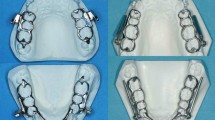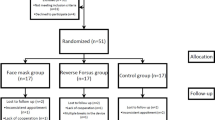Abstract
Objective
The objective of the present study is to compare the effects on soft tissue profile in class II patients after treatment with either “Functional Mandibular Advancer” (FMA) or Herbst appliance.
Materials and methods
The study included n = 42 patients treated with either FMA (n = 21) or Herbst appliance (n = 21) by the same experienced orthodontist. The treatment followed a single-step advancement protocol. Lateral cephalograms were analyzed through a set of customized measurements. The actual therapeutic effect was calculated using data from a growth survey. After testing for normal distribution and homogeneity of variance, data were analyzed by one-sample Student’s t tests and independent Student’s t tests. Statistical significance was set at p < 0.05.
Results
For both FFAs, significant upper lip retrusion, increase in lower lip’s thickness, and length of the lower face occurred. Additionally, significant lower lip retrusion and straightening of the profile were found in FMA and Herbst appliance patients. All remaining variables revealed no significant differences.
Conclusions
Treatment-related changes on the facial soft tissue profile could be regarded similar in class II patients treated with FMA or Herbst appliance. No treatment-related changes that were specific for FMA or Herbst appliance could be identified. Only moderate changes were noted comparing pre- and posttreatment soft tissue profiles.
Clinical relevance
Despite proven differences in skeletal and dental treatment effects, the facial profile has not to be taken into consideration when choosing between FMA and Herbst appliance for class II treatment.


Similar content being viewed by others
References
Bishara SE (2006) Class II malocclusions: diagnostic and clinical considerations with and without treatment. Semin Orthod 12:11–24
Flores-Mir C, Major MP, Major PW (2006) Soft tissue changes with fixed functional appliances in class II division 1. Angle Orthod 76:712–720
Koretsi V, Zymperdikas VF, Papageorgiou SN, Papadopoulos MA (2015) Treatment effects of removable functional appliances in patients with class II malocclusion: a systematic review and meta-analysis. Eur J Orthod 37:418–434
Kinzinger GSM, Lisson JA, Frye L, Gross U, Hourfar J (2017) A retrospective cephalometric investigation of two fixed functional orthodontic appliances in class II treatment: Functional Mandibular Advancer vs. Herbst appliance. Clin Oral Investig 1–12
Pancherz H, Anehus-Pancherz M (1994) Facial profile changes during and after Herbst appliance treatment. Eur J Orthod 16:275–286
Peck H, Peck S (1970) A concept of facial esthetics. Angle Orthod 40:284–318
Pancherz H (1979) Treatment of class II malocclusions by jumping the bite with the Herbst appliance. A cephalometric investigation. Am J Orthod 76:423–442
Kinzinger G, Ostheimer J, Förster F, Kwandt PB, Reul H, Diedrich P (2002) Development of a new fixed functional appliance for treatment of skeletal class II malocclusion first report. J Orofac Orthop 63:384–399
Pancherz H (2003) History, background, and development of theHerbst appliance. Semin Orthod 9:3–11
Herbst E (1934) Dreißigjährige Erfahrungen mit dem Retentions-Scharnier. Zahnärztl Rundsch 43:1515–1524
Herbst E (1934) Dreißigjährige Erfahrungen mit dem Retentions-Scharnier. Zahnärztl Rundsch 43:1563–1568
Herbst E (1934) Dreißigjährige Erfahrungen mit dem Retentions-Scharnier. Zahnärztl Rundsch 34:1611–1616
Pancherz H, Ruf S (2008) The Herbst appliance: research-based clinical management. Quintessence, Chicago
Kinzinger GS, Diedrich PR (2005) Bite jumping with the Functional Mandibular Advancer. J Clin Orthod 39:696–700
Pancherz H (1985) The Herbst appliance—its biologic effects and clinical use. Am J Orthod 87:1–20
Ruf S, Pancherz H (1999) Temporomandibular joint remodeling in adolescents and young adults during Herbst treatment: a prospective longitudinal magnetic resonance imaging and cephalometric radiographic investigation. Am J Orthod Dentofac Orthop 115:607–618
Frye L, Diedrich PR, Kinzinger GS (2009) Class II treatment with fixed functional orthodontic appliances before and after the pubertal growth peak - a cephalometric study to evaluate differential therapeutic effects. J Orofac Orthop 70:511–527
Kinzinger G, Kober C, Diedrich P (2007) Topography and morphology of the mandibular condyle during fixed functional orthopedic treatment—a magnetic resonance imaging study. J Orofac Orthop 68:124–147
Kinzinger G, Frye L, Diedrich P (2009) Class II treatment in adults: comparing camouflage orthodontics, dentofacial orthopedics and orthognathic surgery—a cephalometric study to evaluate various therapeutic effects. J Orofac Orthop 70:63–91
Zymperdikas VF, Koretsi V, Papageorgiou SN, Papadopoulos MA (2016) Treatment effects of fixed functional appliances in patients with class II malocclusion: a systematic review and meta-analysis. Eur J Orthod 38:113–126
Ruf S, Pancherz H (1999) Dentoskeletal effects and facial profile changes in young adults treated with the Herbst appliance. Angle Orthod 69:239–246
Baysal A, Uysal T (2013) Soft tissue effects of twin block and Herbst appliances in patients with class II division 1 mandibular retrognathy. Eur J Orthod 35:71–81
de Almeida MR, Flores-Mir C, Brandao AG, de Almeida RR, de Almeida-Pedrin RR (2008) Soft tissue changes produced by a banded-type Herbst appliance in late mixed dentition patients. World J Orthod 9:121–131
Ruf S, Pancherz H (2006) Herbst/multibracket appliance treatment of class II division 1 malocclusions in early and late adulthood. A prospective cephalometric study of consecutively treated subjects. Eur J Orthod 28:352–360
Kinzinger G, Diedrich P (2005) Skeletal effects in class II treatment with the Functional Mandibular Advancer (FMA)? J Orofac Orthop 66:469–490
Bhatia SN, Leighton BC (1993) A manual of facial growth: a computer analysis of longitudinal cephalometric growth data. Oxford University Press, Oxford
IRCP (2001) Radiation and your patient—a guide for medical practitioners. ICRP Supporting Guidance 2. Available at: http://www.icrp.org/publication.asp?id=ICRP%20Supporting%20Guidance%202. Accessed: 2016-15-03. Ann IRCP 31
Dahlberg G (1940) Statistical methods for medical and biological students. Interscience Publications, New York
Lines PA, Lines RR, Lines CA (1978) Profilemetrics and facial esthetics. Am J Orthod 73:648–657
Burstone CJ (1967) Lip posture and its significance in treatment planning. Am J Orthod Dentofac Orthop 53:262–284
Sinno HH, Markarian MK, Ibrahim AM, Lin SJ (2014) The ideal nasolabial angle in rhinoplasty: a preference analysis of the general population. Plast Reconstr Surg 134:201–210
Gunay EA, Arun T, Nalbantgil D (2011) Evaluation of the immediate dentofacial changes in late adolescent patients treated with the Forsus FRD. Eur J Dent 5:423–432
Oztoprak MO, Nalbantgil D, Uyanlar A, Arun T (2012) A cephalometric comparative study of class II correction with Sabbagh Universal Spring (SUS(2)) and Forsus FRD appliances. Eur J Dent 6:302–310
Uyanlar A, Nalbantgil D, Arun T (2014) Evaluation of dentofacial changes caused with Sabbagh Universal Spring in mandibular retrognathic patients: a pilot study. Dentistry 4:237
Meyer-Marcotty P, Kochel J, Richter U, Richter F (2012) Reaction of facial soft tissues to treatment with a Herbst appliance. J Orofac Orthop 73:116–125
Tatarunaite E, Playle R, Hood K, Shaw W, Richmond S (2005) Facial attractiveness: a longitudinal study. Am J Orthod Dentofac Orthop 127:676–682
Xu TM, Korn EL, Liu Y, Oh HS, Lee KH, Boyd RL, Baumrind S (2008) Facial attractiveness: ranking of end-of-treatment facial photographs by pairs of Chinese and US orthodontists. Am J Orthod Dentofac Orthop 134:74–84
Varlık SK, Demirbas E, Orhan M (2010) Influence of lower facial height changes on frontal facial attractiveness and perception of treatment need by lay people. Angle Orthod 80:1159–1164
von Bremen J, Erbe C, Pancherz H, Ruf S (2014) Facial-profile attractiveness changes in adult patients treated with the Herbst appliance. J Orofac Orthop 75:167–174
Mees S, Jimenez Bellinga R, Mommaerts MY, De Pauw GA (2013) Preferences of AP position of the straight Caucasian facial profile. J Craniomaxillofac Surg 41:755–763
Naini FB, Donaldson AN, McDonald F, Cobourne MT (2012) Assessing the influence of lower facial profile convexity on perceived attractiveness in the orthognathic patient, clinician, and layperson. Oral Surg Oral Med Oral Pathol Oral Radiol 114:303–311
Ruf S, Pancherz H (2004) Orthognathic surgery and dentofacial orthopedics in adult class II division 1 treatment: mandibular sagittal split osteotomy versus Herbst appliance. Am J Orthod Dentofac Orthop 126:140–152
Booij JW, Goeke J, Bronkhorst EM, Katsaros C, Ruf S (2013) Class II treatment by extraction of maxillary first molars or Herbst appliance: dentoskeletal and soft tissue effects in comparison. J Orofac Orthop 74:52–63
Barnett GA, Higgins DW, Major PW, Flores-Mir C (2008) Immediate skeletal and dentoalveolar effects of the crown- or banded type Herbst appliance on class II division 1 malocclusion. Angle Orthod 78:361–369
Pancherz H (1982) The mechanism of class II correction in Herbst appliance treatment. A cephalometric investigation. Am J Orthod Dentofac Orthop 82:104–113
Aras I, Pasaoglu A, Olmez S, Unal I, Tuncer AV, Aras A (2016) Comparison of stepwise vs single-step advancement with the Functional Mandibular Advancer in class II division 1 treatment. Angle Orthod 1:1
Talass MF, Talass L, Baker RC (1987) Soft-tissue profile changes resulting from retraction of maxillary incisors. Am J Orthod Dentofac Orthop 91:385–394
Ricketts RM (1960) Cephalometric synthesis. Am J Orthod 46:647–673
Ramos AL, Sakima MT, Pinto Ados S, Bowman SJ (2005) Upper lip changes correlated to maxillary incisor retraction—a metallic implant study. Angle Orthod 75:499–505
Hershey HG (1972) Incisor tooth retraction and subsequent profile change in postadolescent female patients. Am J Orthod 61:45–54
Nanda V, Gutman B, Bar E, Alghamdi S, Tetradis S, Lusis AJ, Eskin E, Moon W (2015) Quantitative analysis of 3-dimensional facial soft tissue photographic images: technical methods and clinical application. Prog Orthod 16:015–0082
Cevidanes LHC, Motta A, Proffit WR, Ackerman JL, Styner M (2010) Cranial base superimposition for 3D evaluation of soft tissue changes. Am J Orthod Dentofac Orthop 137:S120–S129
Author information
Authors and Affiliations
Corresponding author
Ethics declarations
Conflict of interest
The authors declare that they have no conflict of interest.
Funding
The work received no funding.
Ethical approval
This article does not contain any studies with human participants or animals performed by any of the authors. Ethical approval for this retrospective study was granted by the Ethics Commission of University of Aachen, Germany, No. 171/08.
Informed consent
For this type of study, formal consent is not required.
Rights and permissions
About this article
Cite this article
Hourfar, J., Lisson, J.A., Gross, U. et al. Soft tissue profile changes after Functional Mandibular Advancer or Herbst appliance treatment in class II patients. Clin Oral Invest 22, 971–980 (2018). https://doi.org/10.1007/s00784-017-2177-0
Received:
Accepted:
Published:
Issue Date:
DOI: https://doi.org/10.1007/s00784-017-2177-0




